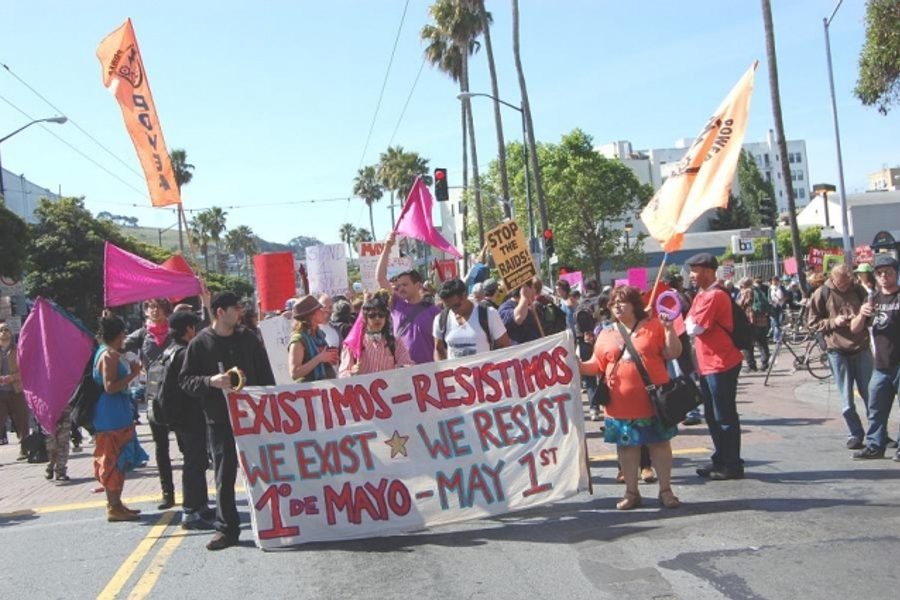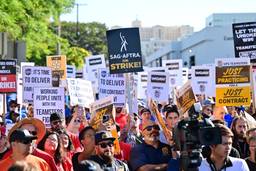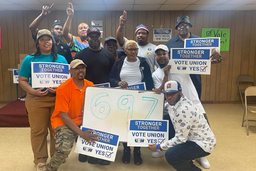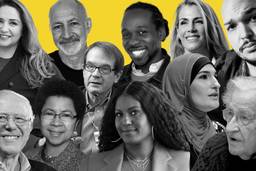
The waves of protests and rallies on May Day 2012 had barely cleared out when police happened upon more than 100 undocumented immigrants locked in isolated houses near the Texas border. After being trapped for days deprived of food and water, they were turned over to the border patrol. May First is supposed to be a day to remember the struggles of labor and the poor, but these migrants were forgotten, like so many of the border’s economic refugees.
May Day has historically had a pro-migrant message, from its origins in 19th-century working-class Chicago, to its revival in 2006 as a day of protest for immigration reform. But this year, even with the added momentum of Occupy Wall Street, the pro-immigrant mobilizations were relatively modest, according to advocates, though the struggles facing immigrants are growing more dire.
While the Occupy banner blanketed much of May Day, demonstrations in several U.S. cities incorporated immigrant rights groups, including protests against Arizona’s draconian immigration law SB 1070, currently under review by the Supreme Court, and the Obama administration’s sweeping deportation policies. New York City’s May Day Solidarity Coalition brought together groups that link labor, immigration, and economic justice, like the New York Taxi Workers Alliance and Domestic Workers United.
But immigration issues weren’t highlighted as they were in May Day 2006 – possibly a reflection of activist fatigue that’s sunk in after so many years of stonewalling by politicians. And tactically, it might be hard to wrap the purposefully amorphous Occupy ethos around the everyday struggles of immigrants who live in perpetual fear of being ripped apart from their families and deported. Occupy’s focus on direct action and building alternative political communities might not resonate with immigrants who are frightened to even venture outside their homes.
Catherine Tactaquin, executive director of National Network for Immigrant and Refugee Rights told In These Times that some of the challenges stemmed from legal obstacles that could impede many immigrant activists:
Some of our members struggled with how to address May Day given the presence of Occupy. … They faced a dilemma that many immigrant community groups have faced concerning the Occupy mobilizations. When the mobilizations include civil disobedience, or are prone to various types of [civil disobedience] actions by some groups, it puts immigrant community members at risk – not just of arrest, but deportation. These are not the spaces that we saw in 2006, when the immigration mobilization achieved both a public presence and the inclusion of millions of immigrant workers and their families.
In Tucson, Arizona, Kat Rodriguez of Coalición de Derechos Humanos said local immigrant advocates had worked closely with Occupy groups to coordinate May Day demonstrations, but in the end, “the simple reality is that many people were not able or willing able to risk not showing up to work or were unable to get the day off.”
At the same time, the broad-based horizontalism of Occupy could inject fresh energy into the embattled immigrant rights movement. In 2006, the national conversation on immigration revolved around comprehensive immigration reform through federal legislation to legalize millions of undocumented immigrants. But that effort fizzled amid gridlock in Washington, leaving many activists feeling deflated and frustrated.
Today, immigration reform now faces a more diffuse array of threats across the country: mass imprisonment and expulsion, Sheriff Joe Arpaio’s anti-migrant crusade in Maricopa County, Arizona, the crippled aspirations of undocumented students, the unbridled exploitation of immigrant workers in fields, factories and households. There’s currently little political appetite in Congress for major reforms, and hateful rhetoric is swallowing up state legislatures. But despite dim prospects for a full overhaul of the system, there’s still work to be done on the community level to defend immigrant workers’ labor rights, fight discriminatory policing and campaign to keep immigrant families intact. Tactaquin said although truly comprehensive reform remains a long-term goal–
The local and state work – which is also important to help transform the public thinking about immigration – must also continue, and will strengthen local organizing work, build greater capacity and bring on important allies…. We’re excited about the possibilities of greater work with our “traditional” allies with labor and the faith communities, but also with the women’s community, African-Americans, health care providers, LGBT rights movement and more.
If there’s one strength that the immigrant rights movement can draw from Occupy, it’s the growing realization that the struggles for civil rights, economic justice, fair labor policies and a strong social safety net are all interlocked – and that the movements working toward these aims must be accessible to all communities. Occupy might provide a platform to tackle cross-cutting issues of human rights, labor rights, globalization, and the expanding police state.
Critics have criticized Occupy as too shapeless to bring about substantive change, but the battle for immigrants’ rights could be an opportunity to prove them wrong. May Day 2012 didn’t have a concrete agenda but it opened a forum for voices that are typically silenced and ignored. And while racist hostility pervades the mainstream political arena, Occupy may be one of the only spaces left for immigrants to speak up without fear.
Michelle Chen is a contributing writer at In These Times and The Nation, a contributing editor at Dissent and a co-producer of the “Belabored” podcast. She studies history at the CUNY Graduate Center. She tweets at @meeshellchen.








